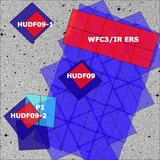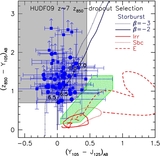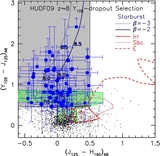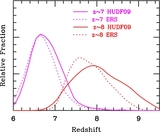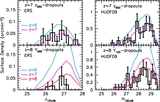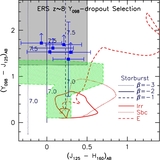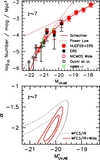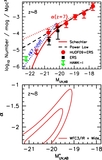Image Details
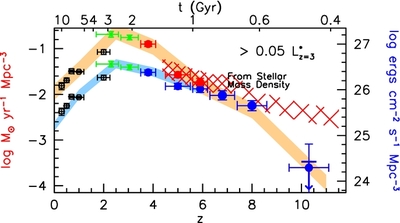
Caption: Figure 17.
Comparison of the SFR density determinations at
z
![]() 4 with that implied by recent determinations of the stellar mass density (Section 7.4). The red hatched region gives the
SFR densities implied by current compilations of the stellar mass density at
z
4 with that implied by recent determinations of the stellar mass density (Section 7.4). The red hatched region gives the
SFR densities implied by current compilations of the stellar mass density at
z
![]() 4 (Labbé et al. 2010a, 2010b; Stark et al. 2009; González et al. 2010) where the width of this region indicates a roughly
±1σ uncertainty. The change in density of the cross-hatching at
z > 7 is intended to indicate that the mass-density-derived SFR may be more subject to systematic uncertainty from limited
measurements and the extrapolation required from the measurements at
z ≲ 7. At
z
4 (Labbé et al. 2010a, 2010b; Stark et al. 2009; González et al. 2010) where the width of this region indicates a roughly
±1σ uncertainty. The change in density of the cross-hatching at
z > 7 is intended to indicate that the mass-density-derived SFR may be more subject to systematic uncertainty from limited
measurements and the extrapolation required from the measurements at
z ≲ 7. At
z
![]() 8, the stellar mass density in galaxies brightward of −18 AB mag is assumed to scale with redshift as (1 +
z)
−4.4 (as found in Labbé et al. 2010b). Interestingly, at
z < 7 the mass-density-derived SFR is only about 40% larger than the SFR density estimated from the LFs; such a small difference
is quite encouraging. This suggests that (1) the IMF at high redshift (
z ~ 4–7) may not be that different from what it is at later times and (2) that stellar mass density estimates at
z > 4 are reasonably accurate.
8, the stellar mass density in galaxies brightward of −18 AB mag is assumed to scale with redshift as (1 +
z)
−4.4 (as found in Labbé et al. 2010b). Interestingly, at
z < 7 the mass-density-derived SFR is only about 40% larger than the SFR density estimated from the LFs; such a small difference
is quite encouraging. This suggests that (1) the IMF at high redshift (
z ~ 4–7) may not be that different from what it is at later times and (2) that stellar mass density estimates at
z > 4 are reasonably accurate.
Copyright and Terms & Conditions
© 2011. The American Astronomical Society. All rights reserved.


